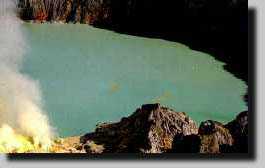
 Anyone travelling on a clear day
across the narrow strait separating East Java and Bali will almost certainly
be impressed by the two towering mountain peaks dominating the Javanese
horizon. These are the summits of Mt Merapi and the crater rim of Ijen,
just two points lying on the edge of a vast caldera, which at its widest
point is some 20 km in diameter. Anyone travelling on a clear day
across the narrow strait separating East Java and Bali will almost certainly
be impressed by the two towering mountain peaks dominating the Javanese
horizon. These are the summits of Mt Merapi and the crater rim of Ijen,
just two points lying on the edge of a vast caldera, which at its widest
point is some 20 km in diameter.
The Ijen plateau lies in the centre of the Ijen Merapi-Maelang Reserve, which extends over much of the mountainous region directly west of Banyuwangi and borders on the Baluran National Park in the north east. As at Bromo, the caldera is best viewed from the air.
Fortunately, almost all commercial flights operating between Denpasar and Surabaya, Yogyakarta or Jakarta usually fly, if not directly over, then close by the Ijen plateau, where the seemingly luminous blue/green crater lake forms an unmistakeable landmark. The lake lies at the far eastern end of the plateau and is without doubt among the most impressive of East Java's natural wonders. Despite the long and arduous journey along punishing roads (a four wheel drive vehicle is essential), the trip to Ijen is more than worth the effort and is sure to prove an unforgettable experience for anyone who makes it to the end of the trail.
Kawah (crater) Ijen can be reached from either the east or the west.
The latter is the more popular approach, since the climb from the road's
end to the edge of the lake is only one and a half hours. The road from
Banyuwangi, on the other hand, involves a six to seven hour trek from
the village of Licin. The western route starts from Wonosari, a few
kilometres outside Bondowoso, the town famous for its bull fights. A
narrow road, full of potholes, runs east and up from Wonosari, rapidly
deteriorating into bone shaking loose rock and gravel. Seemingly endless
hairpin bends ascend into forests of casuarina (cemara) trees, giving
way to pine forests and coffee plantations. The temperature drops. At
night, near the crater rim, it can fall to about 5 degrees celsius.
The road ends at Jampit, where very basic shelter is available. It is
also possible to sleep in the old vulcanology station further up the
hill, now used by sulphur collectors, but permission must be obtained
in advance.
Visit
Ijen Crater website with many Photos
|
